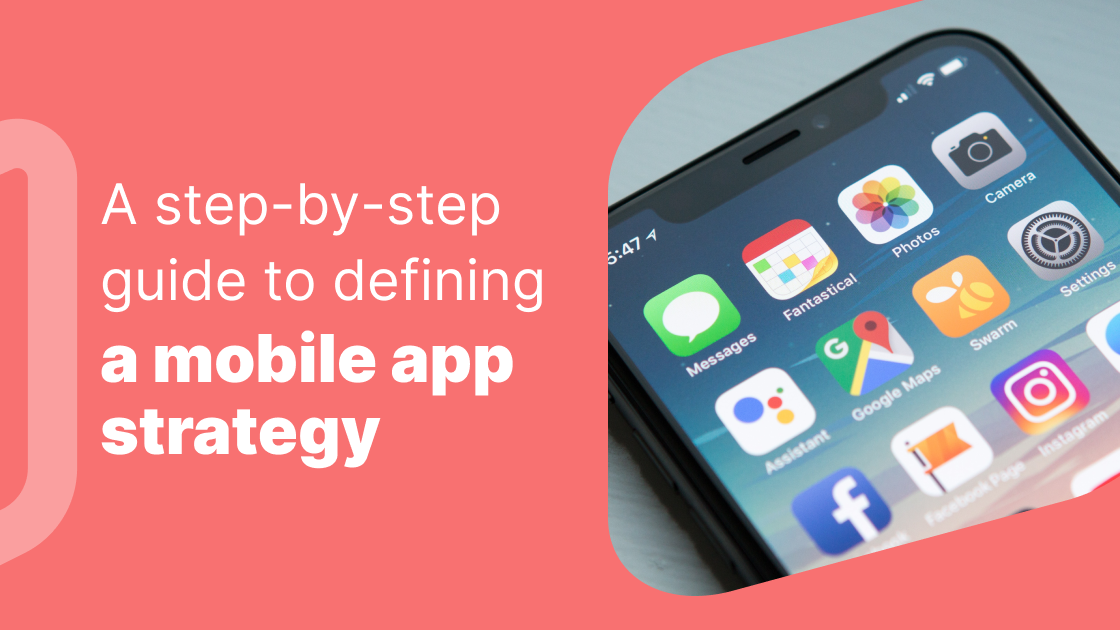In order to create a successful mobile app, you need to have a well-defined strategy in place. This article will provide you with the steps necessary to develop a plan that will help your app stand out from the competition.
So, you want to develop a mobile app?
The mobile app industry is a fierce market. There are currently more than 5.1 million apps available to download via the Google Play Store and Apple App Store combined, and the sector is set to hit $565 billion in revenue by 2026. That’s a lot of competition so, how can developers and marketers ensure that their apps stands out? By defining a definitive and effective mobile app strategy.
There are so many steps and considerations to think about when coming up with a mobile app strategy. This guide will show you how to do it, step-by-step.
Step 1: Pre-strategy planning
Before even thinking about developing a strategy or putting pen to paper, you need to look at factors that will drive your mobile app strategy – think of it as the pre-strategy planning phase, i.e. conducting the research required to inform the strategy itself. So, let’s start at the top…
What are your business objectives?
This could be one thing or a number of things. However, it’s important to note that your mobile app strategy should support these overall business goals. Start at the very top and engage with stakeholders and senior execs to fully understand the company’s overall strategy and work down from there. Ask questions like:
- What is the mission of the company?
- What is the company’s vision?
- What are the objectives? I.e. what is the final outcome your company’s strategy wants to achieve?
- What is the scope of the strategy?
- What is your competitive advantage?
Market research
Once you’ve got a clear understanding of the overall business strategy, it’s time to get stuck into some deep research. Look at the competitors within the specific app category you’re looking to enter – what pain point are they addressing and for who? Look at their customer demographics and the things they aren’t happy with in the current market. Is that particular market already saturated with apps addressing those exact customer pain points? Recent findings show that the Apple App Store received over 3,100 app submissions during March 2022 – so asking these questions is critical to ensure the best chance of success. There’s little use in developing an app that either doesn’t alleviate a customer pain point or that will only be added to an overwhelming list of other apps that are already doing what you do, and perhaps even better.
Identify end user pain points
One of the most important aspects of developing a successful mobile app strategy is identifying user pain points. By understanding the specific needs and wants of your target audience, you can develop an app that provides real value and solves real problems.
The three most important ways to identify user pain points include:
- User feedback - Collecting feedback, such as interviews, surveys, or even reading customer support tickets, can offer valuable insightful information about your app and any user difficulties you need to fix.
- App analytics - App analytics data can also be helpful in identifying user pain points by showing you areas where users are dropping off or struggling.
- User testing - Get real users in your target market’s demographic try to accomplish tasks within your app and see where they run into difficulty. If you don’t yet have an app, you can do user testing on competitor apps to see if there are UX problems you can try to avoid to gain a competitive advantage.
Competitor strategy analysis
With a list of competitors to hand, you now need to look at their product marketing, sales, and marketing tactics, to see what they’re doing well, and avoid any mistakes they’re making. You will also likely discover things your competitors are not doing at all, which may provide an opportunity to differentiate yourself in a difficult and competitive market. What stands out to you - are they doing anything unique that you perhaps haven’t seen before? If so, why? These are all questions to consider when conducting a competitor strategy analysis. Once you’ve answered these questions, you’ll have a pretty good idea of how your competitors work and how you can ensure your app will be even better.
SWOT analysis
The idea behind conducting a SWOT analysis is to discover the strengths, weaknesses, opportunities, and threats relating to the mobile app you want to develop. Look at what your app could do well and where there may be room for improvements. Also, look at the opportunities it may present to your customers or to the business as a whole – think back to the overall business goals that you’re looking to support here. Finally, look at the threats associated, i.e. anything on the outside that might impact your app. Aspects such as failing to recruit developers or shifting markets can have a huge impact. As long as the strengths and opportunities outweigh the weaknesses and threats, you have a solid idea.
Determine the budget
The last pre-strategy stage is to develop a budget for your mobile app. Based on all of the findings from the above sections, you need to produce a number to achieve the desired results. Key aspects to consider when developing a budget include looking at the overall sales funnel, what operational costs might entail in terms of technology and recruitment, goal setting in terms of revenue and sales or downloads/ engagement/ retention, etc.
Step 2: Define your mobile app strategy
When you’ve got all the pre-strategy planning out of the way, it’s time to start defining your mobile app strategy.
Create user personas
You’ve already looked at the customer pain points during the pre-planning stage, now it’s time to look at creating the user personas within that potential customer base. There are often multiple groups of customers for mobile apps, and it’s important to tailor the customer experience and journey to each group. Develop buyer personas by determining demographics, background, mobile preferences, interests, and unique identifiers and categorizing them accordingly – everything from branding and in-app content to functionality, features, platform choice, and monetization strategy needs to resonate with your target user.
Map the customer journey
Armed with your user personas, it’s time to map out their journeys. Create a visual representation of all possible customer touchpoints and how customers will interact with your brand at each stage. This will include ads, app stores, landing pages, in-app user journeys, social channels, email, as well as interactions with sales and customer support teams. This helps executives step into your customers’ shoes and see your business from their perspective. At each stage, you can include what action a customer needs to take and how your brand responds to ensure that the right actions are being taken at each stage to encourage customers’ along their user journey.
Define KPIs
KPIs are critical to monitoring a mobile app’s success. These metrics should clearly demonstrate the value of your strategy to the company, and should generally include things like:
- Customer Acquisition Cost (CAC)
- Customer Lifetime Value (CLV)
- Lead-to-Revenue Ratio
- New Users
- Active Users (daily, weekly, monthly)
- App Rating
- Retention Rate
- Customer Satisfaction
- Revenue Growth Rate
The above is just a small sample of the sort of KPIs you should be measuring. They will help you see clearly if your app is on the right track, or if you’re not seeing the desired results by the date you’ve set out, you can use that information as evidence to adapt your strategy in order to better support the KPIs you’ve outlined.
Develop airtight positioning
The positioning, key messaging, and Unique Selling Proposition (USP) of your mobile app need to be clear, concise, informative and to the point. To support this, think about the problem you are solving and for whom – why should people care about what you’re doing? USPs are a great place to start when it comes to developing your overall positioning, which will then go on to inform the key messages of your mobile app.
Native or hybrid app?
This is a big question for developers – are you going to build a native or hybrid app? A native app is designed for use on a single platform or operating system, for example, Apple versus Android operating systems. This means that they’re often faster and deliver better performance as they’re designed specifically for that system, but they may be more complex and costly to develop. By being native, apps may benefit from any new smartphone or operating system capabilities (for example, Apple provides a machine learning framework for native iOS apps).
In contrast, a hybrid app is basically a native app that’s fuelled by a website application – Instagram is the most popular example of a hybrid app. Although this may mean that users experience lag as content is accessed via the web in real-time, it also means a quicker, easier, and more agile development cycle as well as controlled costs. Flutter and React Native are the market-leading hybrid frameworks used by app developers. Both platforms use a single codebase and can be used to develop apps relatively quickly compared to native app frameworks.
iOS, Android, or both?
This is another one of the big questions. iOS is considered the easier environment in which to develop mobile apps because they require less development time and are generally cheaper and easier to maintain, plus, Apple’s native programming language, Swift, is largely more convenient and requires less coding work. However, Android holds the majority of the mobile operating system market share – a staggering 71.59% in fact – so developers need to seriously weigh up ease of development versus market size for each operating system prior to deciding which to use. And with Kotlin, an open source programming language supported by Android, app developers may build apps faster.
In-house or external agency?
Once the above questions have been answered, it’s time to decide if you want to create the mobile app in-house or outsource some of the heavy lifting. Two of the main differentiators are cost and readiness.
Hiring more in-house employees comes with a significant cost attached as several full-time salaries need to be paid, and finding the right talent takes time. Another factor to consider is if this is your first mobile app strategy: getting in-house employees (existing or new) up to speed is another process that will take time and you may find that bringing in external expertise in the form of an agency or consultancy will help.
However if you already have an in-house app development team, with a track record of delivering successful mobile apps, then it goes without saying that you shouldn’t require external support. This may only be required if, for example, you were looking to break into a different app market with different user personas and you needed support on redefining your mobile app strategy.
The decision to invest internally or outsource is often a matter of willingness to internalize expertise: does a developer want to build tech expertise internally in order to enhance the skills and value of the company? The answer to this will depend on the long-term goals of the company.
Step 3: Go-to-market (GTM) app strategies for mature mobile-only businesses
The go-to-market (GTM) strategy you develop and implement will depend very much on the type of business you have and your familiarity with the app ecosystem. There are:
- Immature app publishers: these businesses who may be launching an app for the first time without any existing brand assets or user base.
- Mature app publishers: these have been around for up to ten years or more, with a portfolio of existing apps and an existing user base which they can leverage as part of their launch strategy.
Within each of these categories, there will be traditional companies (e.g. banks or web-centric organizations such as airlines) and mobile-only businesses (i.e. companies who only publish mobile apps). Some of the key strategic differences for these types of companies include the fact that:
- Traditional companies can leverage offline communication channels e.g. print or TV.
- Traditional companies can leverage large existing customer bases and brand awareness.
- Traditional web-centric companies, like retail stores with e-commerce sites, can leverage their email lists and customers who visit their website.
For the purposes of this article, we’re going to focus on the go-to-market strategy for mature mobile-only companies. To read more about the various GTM strategies for different types of businesses, we will release soon another article Choosing The Right Go-To-Market App Strategy For Your Mobile App.
Landing pages
First, your app needs a landing page. Why? Mobile sites are the number one source of mobile app installs. This should go both for pre and post-launch. Provide users with a teaser video or countdown page to create excitement around the launch. Post-launch, it’s also crucial to provide your potential user base with all the additional information surrounding your app that they won’t find within the actual app itself. Things to include are the context/ background of the app, i.e. why it was developed in the first place, user reviews, visuals from within the app itself so users know what to expect, and a clear CTA with links to where the app can be downloaded via app stores.
SEO
You also need to consider the SEO on your landing and/or pre-launch page. Leveraging SEO on a pre-launch page is a great way to build domain authority before your app even launches. Likewise, if you’ve created a resource center or blog, effective SEO is critical to attracting new users.
- Choose the right keywords – ensure you do the research and include keywords in titles and URLs.
- Write high-quality content that will convert potential users into customers.
- Add image names and alt tags to give Google a better view of your overall content.
- Use internal links to keep users on your site.
- Think about how your text is formatted – properly formatted text will enhance reader experience and influence how Google regards your content.
- Ensure your page loads fast – Google wants to provide users with the most relevant piece of content in the quickest timeframe.
- Is it mobile-friendly? It might sound obvious, but ensure the content you create is optimized for mobile screens as well as laptops and desktops.
- Provide fresh content – ensure you write on the topics your users care about on a regular basis.
User Acquisition Via Paid advertising
Organic reach has been declining across mature social platforms for years, meaning paid advertising is a non-negotiable cost when it comes to promoting your mobile app. The three most common types of paid advertising are:
Facebook Ads. With 2.9 billion active monthly users and counting, Facebook remains the leading social media platform. 49% of social ads drive app downloads, and with one in three users expected to make a purchase on Facebook in 2022, advertising on Facebook is a must.
Google Ads. Search ads drive 50% of app downloads. Advertising on Google has become an essential cog of an effective app download strategy.
YouTube Ads. YouTube has become a mainstream media channel with 2.6 billion active users. It gives you the opportunity not only to advertise, but to have a dedicated channel where you can put out videos on a regular basis.
Apple Search Ads. Another essential acquisition channel for mobile app developers is Apple Search Ads, a pay-per-click advertising platform that allows app developers to promote their apps through Apple's App Store search results. It’s a powerful way to reach potential customers who are already interested in the type of app you offer.
Remember, which user acquisition channels you choose to leverage will depend on your target audience. For example, if you’re targeting millennials or Gen Z with your app, advertising on Instagram and TikTok will be particularly effective.
Organic social media
Ideally, an organic social media strategy should work alongside your paid strategy to generate the best results. Alongside the zero cost element, organic social can also establish greater transparency and trust in your brand as you’re only interacting with followers rather than targeting new ones. It’s also a great way to engage with users directly via custom hashtags, direct messages and replies, and encouraging user-generated content. Community engagement is hugely important in today’s customer-focused digital environment, and organic social is one of the best places to do that.
Influencer marketing
Reach new users and promote your mobile app by leveraging influencer marketing. 2020 saw a 65% increase in influencer marketing budget within the mobile app industry so, if you haven’t considered it yet, now is the time to do so. There are numerous ways to work with influencers to achieve your marketing goals, some of the most common include offering free goods such as subscriptions or In-App Purchases, or you can pay them directly to work with your brand.
Email marketing
Email marketing – when it’s done right – can increase retention and engagement rates and increase the revenue of your mobile app. Getting it wrong can have the direct opposite effect. Start by compiling a relevant email distribution list to update users on updates and promotions but remember, always have an opt-out button should users wish to unsubscribe. The best way to measure the success of your email marketing is to monitor metrics such as bounce rates, click-throughs, and time spent viewing email.
PR
Public relations is a great way to increase the exposure of your mobile app and create excitement around its launch. Incorporating PR into the marketing strategy is growing increasingly popular for mobile app marketers as it garners long-term results and high outreach. For example, share a press release about your mobile app launch event with relevant media outlets to create a buzz around the product launch. Then, once it’s launched, ensure to follow up with another press release to share initial figures and user feedback to generate ongoing interest.
Step 4: Ongoing optimization strategies
The hard work doesn’t stop once you’ve implemented your GTM strategy. Ongoing optimization is just as important and key to refining your app’s performance, implementing customer feedback, and ultimately keeping your customers happy, engaged and your app successful.
A/B testing
There are numerous benefits associated with A/B testing mobile apps. It’s a great way to test whether a particular strategy will work for the majority of your user base before you invest in it. A/B testing can be used to boost conversions, increase engagement, observe the impacts of a new function or feature, learn which tactics work best with specific user personas, and generally gauge a better understanding of user behavior.
App store optimization (ASO)
Optimizing your app’s visibility and position in both the Google Play Store and Apple App Store is key to new user acquisition. Think of your mobile app in the app store a bit like your landing page. It needs to be packaged well, leverage keywords, include in-app screenshots, user reviews and it needs to be visually appealing to your user base, in order to rank high.
Routine Placement Optimization
A placement is used to display a paywall, and it can be used to restrict access at any point of the user journey within your app, including onboarding, on the home screen or settings page, or on a content page, for example. The overall goal of a paywall is to get a non-subscribing user to subscribe, and optimizing placement is key to encouraging this effectively. However, think very carefully about which part of the user journey you want to incorporate placement: including it at the wrong point can result in reduced retention rates.
Subscriber analytics
Gaining insight from your subscriber base is a bonafide way to know your bottom line, grow your business with confidence and make smarter investment decisions. Leveraging subscriber analytics means you know how your subscribers behave and why which is critical to inform your overall strategy and ensure mobile app success.
User feedback
Collecting and acting upon user feedback is critical to app improvement. Ensure you offer more than one way for users to provide feedback, such as an email address to contact, live chat, star reviews on app stores, and more. The more avenues you offer, the more feedback you’ll gain and the better you can make your app.
Push notifications
Push notifications can increase user retention by 10x, but only if they’re done right. Failure to do so can result in disgruntled users, a negative in-app experience, and ultimately, loss of customers and revenue. The key is to know who you’re targeting with your push notifications and at what stage of the customer journey and then tailor the message to provide value to those customers at that time.
Incentivize reviews/referrals
If your goal is to increase engagement and conversions, then one way in which to do this is by incentivizing users to provide reviews or share referrals. Provide users with a reason, i.e. some sort of reward – think along the lines of discounts/ coupons, a month’s free subscription, etc. – to review your app or refer it to a friend or family member. You can personalize and share these incentives via push notifications to the right users, at the right time.
In-App Subscriptions
Further optimize mobile app revenue by incorporating In-App Subscriptions. The media and photo/editor sectors in particular do this very well. For example, a user downloads the app, and if they want to either read more than a few articles a day or access exclusive content or tools, they need to sign up for a monthly subscription. This is a great way to increase engagement and retention as users are actively paying for the product, therefore, are much more likely to use it regularly.
Mobile app strategy: The key takeaways
- Before you develop a strategy, decide what your overall business objectives are so you can align your mobile app strategy with them.
- Market, competitor and SWOT analyzes will inform your strategy and product positioning. Identifying the end user pain point is mandatory.
- Create user personas and may their journeys to ensure you’re targeting the right people at the right point in the sales funnel.
- Define KPIs to measure success.
- Think about the environment in which you want to develop the app and whether you want to develop in-house or seek external support.
- Implement a solid GTM strategy that will increase brand exposure and create hype around your mobile app launch.
- Don’t forget about ongoing optimization strategies, including app store optimization, receiving and implementing user feedback, and tracking subscriber analytics.
Power Your Mobile App Strategy with Purchasely
If you’re looking to enlist the help of an expert to develop your mobile app strategy, then consider Purchasely.
Purchasely provides an In-App Subscription platform for marketers and developers who want to build and optimize their subscription funnels and campaigns in the most effective way. Our software makes the hard stuff easy, and allows you to:
- Enjoy complete control of your in-app campaigns
- Engage with your subscribers at every step
- Run seamless no-code campaigns
- Design visually appealing, branded paywalls
- Access detailed subscriber insights
- Eliminate data discrepancies between platforms
Book a a 30-minute product tour today and learn how Purchasely can make subscription app growth easier for you, or get in touch at hello@purchasely.com.





